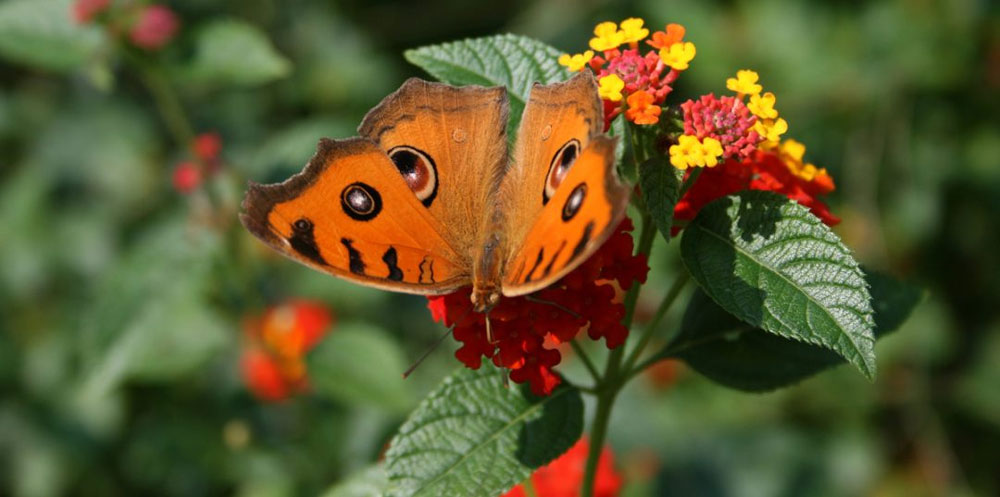
Wondering how to attract butterflies to your yard? The secret is in the plants! Successful butterfly gardens provide a source of food and shelter for these magical creatures. But it’s not all about the excitement of spotting one. Butterflies are important pollinators, meaning they’re also beneficial for the environment. And the key element in every butterfly garden is the right combination of plants! So let’s have a look at the exact plants you need to attract ALL the butterflies to your space.
How to Attract a Variety of Butterflies
Different species of butterflies have different dietary needs. And providing the right food sources is crucial for their survival. So if you’re wondering how to attract butterflies and want a wide variety of visitors, you’ll need to provide a variety of their favorite foods. Let’s take a look at some of the most common species of butterflies that visit your garden. AND the specific plants they need to survive and thrive.
How to Attract Butterflies: Monarchs

The monarch butterfly is one of the most well-known and widely recognized butterfly species. It has a distinctive orange and black pattern on its wings, and is large, with a wingspan of up to 4 inches. The monarch butterfly is famous for its long-distance migrations. Did you know that these incredible creatures travel thousands of miles from breeding grounds in the United States and Canada to overwintering sites in California and Mexico? The caterpillars of this species are black, white, and yellow, and they feed on milkweed plants. So which plants work best for attracting Monarch butterflies? Besides milkweed, other plants include butterfly bush, zinnias, coneflowers, goldenrod, aster, and liatris.
Bring Black Swallowtail Butterflies to Your Yard
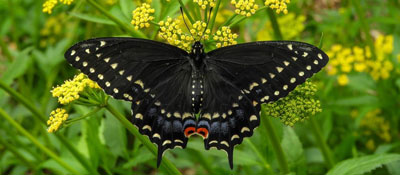
The Black Swallowtail is a large and distinctive North American butterfly. It has black wings with yellow and blue markings and a wingspan of up to 5 inches. The female Black Swallowtail is larger than the male and has more prominent yellow and blue markings on the hind wings. Some plants that are attractive to Black Swallowtails include dill, parsley, and fennel. These plants serve as host plants for the butterfly’s larvae. Besides host plants, Black Swallowtails also love nectar-rich flowers. Some great choices: milkweed, bee balm, coneflowers and yarrow.
How to Attract Butterflies: Painted Ladies

The Painted Lady butterfly is found worldwide. It has a wingspan of up to 2.5 inches, and its wings are orange-brown with black and white markings. The female Painted Lady is larger and more brightly-colored than the male. Some plants that are particularly effective at attracting Painted Lady butterflies? Try thistle, hollyhock, cosmos, pincushion, verbena and zinnias.
Favourite Plants for Red Admiral Butterflies
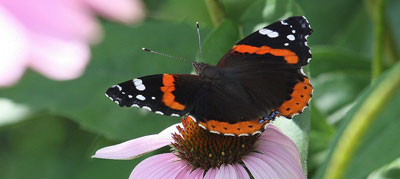
The Red Admiral butterfly is a medium-sized butterfly found throughout North America and Europe. It has dark brown or black wings with distinctive red and white markings, and a wingspan of up to 2.5 inches. It is known for its ability to overwinter as an adult butterfly. It’s often one of the first butterflies spotted in the spring. Some plants that are particularly effective at attracting Red Admiral butterflies include stinging nettles, hops, butterfly bush, bee balm, and coneflowers.
How to Attract Mourning Cloak Butterflies
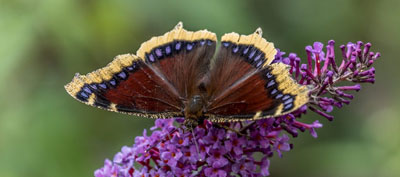
The Mourning Cloak butterfly is a large and distinctive butterfly found throughout North America. It has dark brown or black wings with a blue and yellow border and a wingspan of up to 4 inches. The Mourning Cloak is known for its ability to overwinter as an adult butterfly. They can sometimes make an appearance on warm days during the winter months. Some plants that are particularly effective at attracting Mourning Cloak butterflies include willows, cottonwoods, butterfly bush, goldenrod, and aster.
Favorite Plants for Eastern Tiger Swallowtail Butterflies

The Eastern Tiger Swallowtail butterfly is a large and distinctive butterfly. It has black wings with yellow and blue markings and a wingspan of up to 5 inches. The female Eastern Tiger Swallowtail is larger than the male. The females have more prominent yellow and blue markings on the hind wings. Some plants that are particularly effective at attracting Eastern Tiger Swallowtail butterflies include cherry trees, ash trees, milkweed, butterfly bush, coneflowers, and zinnias.
How to Bring Common Buckeye Butterflies to Your Yard

The Common Buckeye butterfly, is a medium-sized butterfly that lives throughout North America. It has brown and orange wings with distinctive black and white markings and a wingspan of up to 2.5 inches. The Common Buckeye is known for its ability to adapt to a variety of habitats and climates. They are often seen flying during the fall months when many other butterfly species have already disappeared. Some plants that are particularly effective at attracting Common Buckeye butterflies include snapdragons, penstemons, milkweed, bee balm, black-eyed Susan, and coneflowers.
How to Attract Great Spangled Fritillary Butterflies
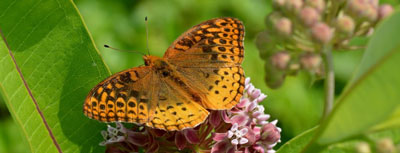
The Great Spangled Fritillary butterfly is a large and striking butterfly found throughout North America. It has orange and black wings with silver spots and a wingspan of up to 3.5 inches. The Great Spangled Fritillary is known for its ability to tolerate a wide range of temperatures and habitats. You might spot one flying in the late summer and early fall. Some plants that are particularly effective at attracting Great Spangled Fritillary butterflies include violets, pansies, milkweed, thistle, coneflowers, and aster.
How to Attract American Lady Butterflies

The American Lady butterfly is a medium-sized butterfly that lives throughout North America. It has orange and brown wings with distinctive black and white markings and a wingspan of up to 2.5 inches. The American Lady is known for its long-distance migrations. You might see them flying in large numbers during the fall months. They are attracted to a variety of flowering plants, including thistle, aster, milkweed, coneflowers, sunflowers, and clover. The American Lady Butterfly likes plants that have brightly colored, fragrant flowers. So choose a variety of flowering plants in different colors and scents. Then wait for the American Ladies to arrive!
Favorite Plants for Viceroy Butterflies
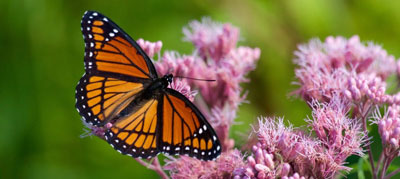
The Viceroy butterfly is a medium-sized butterfly found throughout North America. It has orange and black wings with a distinctive white bar on the hind wings, and a wingspan of up to 2.5 inches. Unlike many other butterfly species, Viceroys do not migrate. Instead, their caterpillars roll up in leaves and enter a state of hibernation. During this time, they remain inactive and use minimal energy to survive the winter. In the spring, when the weather becomes warmer and the plants start to bloom again, the caterpillars emerge from their hibernation. This is when they develop into adult butterflies. Viceroy like a variety of flowering plants, including milkweed, trees like willow and cottonwood, thistle, aster, clover, and yarrow.
How to Attract Gray Hairstreak Butterflies

The Gray Hairstreak butterfly is a small to medium-sized butterfly that is native to North America. You can recognize it by its gray or brown-colored wings, which have black and white markings on the tips and margins. The undersides of the wings are typically a pale gray or white color, with black and orange markings near the body. The Gray Hairstreak butterfly has a wingspan of about 1-2 inches. It likes a variety of flowering plants, including milkweed, thistle, aster, coneflowers, sunflowers, and clover.
How to Bring Pearl Crescent Butterflies to Your Space
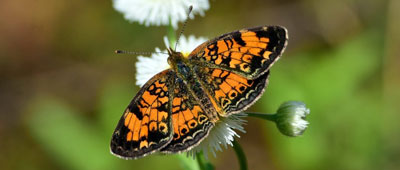
The Pearl Crescent butterfly is a small and colorful butterfly found throughout North America. It has orange and black wings with white spots and a wingspan of up to 1.5 inches. The Pearl Crescent butterfly likes a variety of flowering plants, including daisies, asters, goldenrods, thistle, milkweed, and clover. Pearl Crescent butterflies also feed on the nectar of certain trees. Planting trees such as willows or cottonwoods can also be effective in attracting them.
All About Azure Butterflies

The Azure butterfly is a small, blue-colored insect that is typically less than 1 inch in length. It has a wingspan of between 2-3-inches. The male Azure butterfly is typically a brighter blue color than the female. It also has a distinctive, dark-colored patch on its second abdominal segment. The female Azure butterfly is typically a pale blue or green color, with dark markings on its thorax and abdomen. Azure butterflies like a variety of flowering plants, including milkweed, thistle, aster, coneflowers, sunflowers, and clover. Azures are also known to feed on the nectar of certain trees like willows or cottonwoods.
The Distinctive Question Mark Butterfly
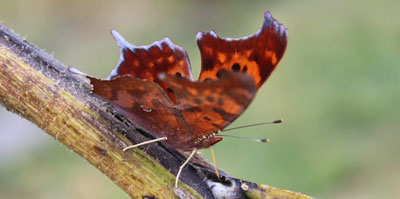
The Question Mark butterfly is a medium-sized butterfly found throughout North America. It has brown and orange wings with distinctive black and white markings and a curved, “question mark” shape on the hind wings. The Question Mark is known for its ability to overwinter as an adult butterfly. So you might spot it flying on warm days during the winter months. The Question Mark butterfly is attracted to a variety of flowering plants, including thistle, milkweed, aster, coneflowers, sunflowers, and clover. The Question Mark butterfly is known to feed on the sap of certain trees. So try planting willows, elms or cottonwoods to help attract them.
Bring Spicebush Swallowtail Butterflies to Your Space
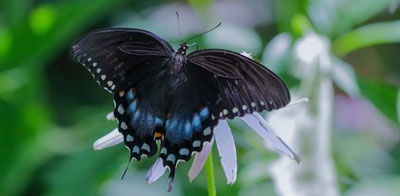
The Spicebush Swallowtail butterfly is a large, black butterfly with distinctive blue and orange markings on the undersides of its wings. The upper sides of the wings are mostly black. They have a row of white spots along the edges and a row of orange spots near the body. The female Spicebush Swallowtail also has a blue spot on each hindwing. The wingspan of this butterfly can range from 1-2-inches. It is named for the spicebush. Which is a type of shrub that is commonly found in its habitat. The spicebush serves as a host plant for the butterfly’s larvae. Spicebush butterflies like a variety of flowering plants, including milkweed, thistle, aster, coneflowers, sunflowers, and clover.
All About American Snout Butterflies
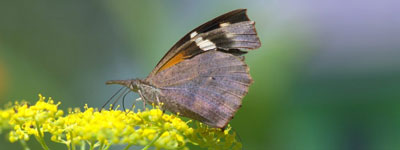
The American Snout butterfly is a small and distinctive butterfly found throughout North America. It has brown and orange wings with black and white markings, and a long, protruding “snout” on the head. The American Snout butterfly is attracted to a variety of flowering plants, including milkweed, thistle, aster, coneflowers, sunflowers, and clover. American Snout butterflies like to feed on the sap of certain trees. Try willows or cottonwoods to bring them to your space.
How to Attract Little Sulphur Butterflies
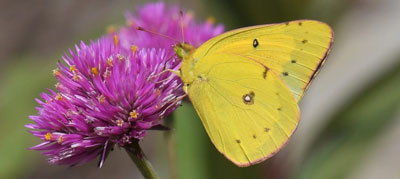
The Little Sulphur butterfly, also known as the clouded sulphur or the common sulphur, is a small butterfly. It’s wingspan is a delicate 1.5-2 inches. It is typically yellow, with black markings on its wings. The wings may also have small white spots, and the edges of the wings are often slightly scalloped. It is a popular butterfly for butterfly enthusiasts to observe and collect. It is attracted to a variety of flowering plants, including milkweed, thistle, aster, coneflowers, sunflowers, and clover. Little Sulphur butterflies also feed on the nectar of certain trees. Try planting willows or cottonwoods to attract them.
Other Plants Butterflies Love
The main focus when creating any butterfly garden is nectar-rich flowers. While there are some specific plants that are sure to attract certain species, there are also some tried and true options that will serve your purpose. Our top picks? Agastache, lantana, baptisia, phlox, catmint, coreopsis, heliotrope, lavender, passionflower, sedum, dutchman’s pipe, eupatorium, salvia, and joe-pye weed.
Finishing Touches
Besides their favorite flowering plants, there are a few other things a butterfly garden should also have! Add in some sources of water, such as a mister, shallow bird bath or a small pond. And provide some places for them to rest and bask in the sun, like rocks, branches, or logs.
Ready to get started attracting butterflies to your garden?





























































































































































































































































































































































































































































































































































































































































